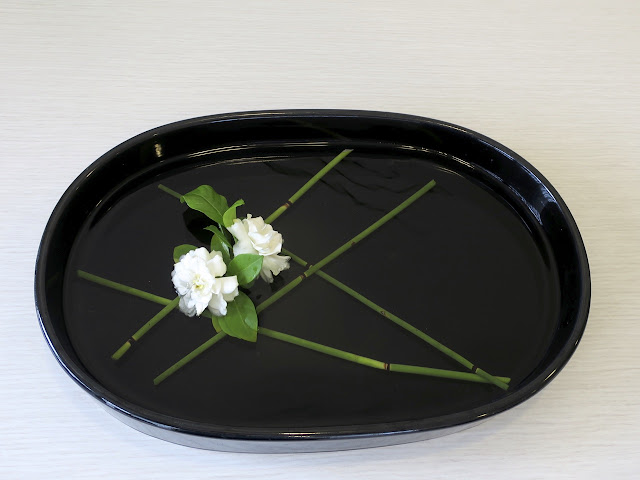The exercise I set in the first class, this year, for my advanced students was a 'summer arrangement emphasising water'. This is a lovely exercise at this time of year and invites the use of glass vessels or suibans that show an expansive surface of water.
Of course there are other more tangential ways of doing the exercise. Below are four examples from different classes.
Kim has gone for a rather minimalist approach, using a shallow glass serving dish. It is not clear in the photo, but he has filled the small recess in the centre of the dish with water. He then placed three short, cut stems at one end of the dish. Teasingly, he has placed a single aspidistra leaf underneath the other end of the dish.
Gianna has used an extra large black suiban, in which she has arranged two gardenias as a focal point in a design created with four stems placed across the vessel.
Val has arranged two pale orange roses under the water in a small rectangular glass vase.
Margaret has used a tall glass cylinder, in which she has floated the large outer petals of an intense pink gerbera. The, now smaller, remainder of the flower sits at the opening of the vase. These elements are contrasted with the line of a vine, which has green leaves with a variegated white patterning.
On Monday last week I attended the first meeting for 2019 of Ikebana International Melbourne Chapter. The guest speaker was a sumi-e (Japanese ink brush painting) artist, Emi Kamataki. Members were asked to make ikebana arrangements reflecting this subject.
I thought I would use bamboo as this is such a beautiful and popular subject in sumi-e. A particularly attractive variety is growing through our fence from a neighbour's garden. It has variegated pale stems with fine green longitudinal lines.
It was the first time I remember using fresh bamboo in ikebana, as the leaves curl very rapidly after picking; but not, however, if you use the following technique recommended to me by a couple of my students: Cut the bamboo early in the morning. When you have brought it inside, cut the stem again underwater and immediately place it in a mug half-filled with hot water containing a teaspoon of dissolved salt. Leave it in the salty water for at least 15 minutes and then place in room temperature fresh water.
My simple ikebana has two tall stems with most of the leaves removed to emphasise the stems. Lower leaves conceal the kenzan and some small off-white begonia flowers create a focus at the edge of the suiban.
See more photos from the meeting at the following link, Ikebana International Melbourne.
Greetings from Christopher
17th February 2019





No comments:
Post a Comment